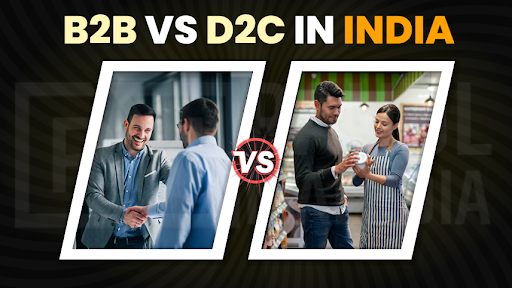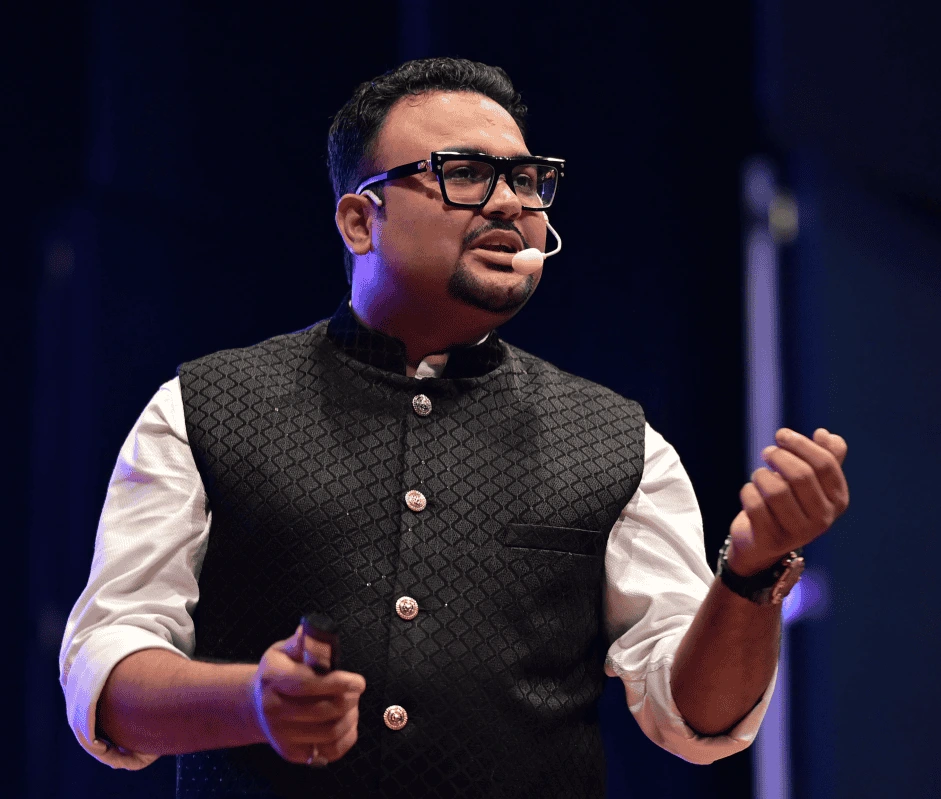
B2B vs D2C in India: Which Business Model Will Win in the Next 5 Years?
The Battle for India’s Next Business Revolution
In the heart of every Indian entrepreneur today, one question keeps rising, Should I go B2B or build a D2C brand? The country is buzzing with opportunity. Startups are popping up in tier-2 cities. MSMEs are transforming into scalable ventures. Digital adoption has never been stronger; businesses everywhere are embracing tech like never before. But amidst all this noise, choosing the right business model can either fuel explosive growth or drag you into a cash-burning struggle.
You're not just picking between B2B or D2C, you're deciding how your entire business connects, grows, and builds trust with its audience. It’s a choice about scalability, margins, trust, marketing, and survival in the brutally competitive Indian market.
The real question is: which one delivers lasting results? Which model will truly dominate India over the next 5 years, B2B (Business-to-Business) or D2C (Direct-to-Consumer)?
Let’s break it down, not like a textbook, but like a real-world business story. Full of facts, real insights, and honest predictions.
India’s B2B Empire: The Silent Giant
At first glance, B2B doesn’t sound sexy. There are no fancy Instagram ads, no influencer promotions, no stylish packaging. But don’t let that fool you. Behind the scenes, B2B is where the real money has always been.
India’s B2B market is currently valued at over $1 trillion and is expected to reach $1.8 trillion by 2028. The major players aren’t shouting on social media, they’re quietly powering supply chains, manufacturing units, and service sectors. Think about companies like Udaan, OfBusiness, and IndiaMART. They’re not flashy, but they’re solving deep-rooted problems and making consistent money.
In fact, Udaan became one of the fastest Indian startups to reach unicorn status by simply connecting kirana stores with manufacturers and wholesalers. No middlemen. No retail margins. Just pure B2B efficiency.
So what makes B2B so strong?
It’s about long-term contracts, repeat customers, and bulk orders. If a business trusts you, they’ll stick with you for years. In India, where business still thrives on personal connections, customer loyalty is pure gold.
But there’s a catch, B2B is a slow game. You need time to build trust. You need to be ready to handle negotiations, credit cycles, and sometimes late payments. It’s not for the faint-hearted.
The D2C Boom: Hype or the Future?
On the other side, D2C (Direct-to-Consumer) is the rebel. D2C brands are redefining modern business in India bold, digital-first, and built to connect directly with customers by cutting out the middlemen. They use social media, storytelling, and sharp design to win hearts, and wallets.
India’s D2C market was worth ₹70,000 crore in 2022, and it's expected to touch ₹1,75,000 crore by 2025, according to Statista. That’s a massive leap.
Think about brands like boAt, Mamaearth, Wakefit, and The Man Company homegrown Indian startups that used clever marketing to build powerful, profitable businesses.
These aren’t old-school brands. They started small, often from a single room or a garage, and built brands that now compete with international giants.
In just six years, Mamaearth grew from a small startup to a ₹1,000 crore brand, proving how fast a purpose-driven business can scale in today’s market. All thanks to a deep understanding of consumer preferences, sharp influencer marketing, and a product line that clicked with the modern Indian parent.
D2C gives you high margins, direct consumer feedback, and lightning-fast brand building. But here’s the brutal truth, it’s also brutally expensive to sustain. Customer acquisition cost in India is rising fast and it's hitting businesses where it hurts.
Running ads on Meta or Google can drain your budget within weeks. Without strong retention and word-of-mouth, many D2C brands bleed more money than they make.
What the Indian Consumer is Telling Us
Understanding where India is heading also means understanding how Indians are buying. And there’s a major shift happening, especially post-COVID.
Consumers now prefer personalized experiences. They want transparency. They want direct access to brands. That’s a win for D2C.
At the same time, over 70% of India’s population still buys offline. Trust is still built face-to-face, especially in semi-urban and rural markets. For these regions, B2B channels are still the backbone. For example, while a D2C brand may dominate urban skincare sales online, it’s the B2B distributor who makes it available in a salon in Jabalpur or a shop in Meerut.
So the divide isn’t so clean anymore. Urban India learns D2C. Bharat, the real, vast India, still runs on B2B.
What Investors Are Betting On
If you want to spot the future, just follow where the money flows. In the last five years, direct-to-consumer (D2C) brands have captured the spotlight, especially with venture capitalists. Since 2016, India has seen over 800 D2C startups emerge, and by 2023, the sector had attracted a massive $2 billion in funding.
But now the tide is shifting.
Investors are getting cautious about D2C burn rates. They're starting to look for startups that focus on profitability, not just brand-building. B2B startups like OfBusiness and Moglix have raised massive rounds because they promise scale with margins.
A B2B company may not go viral, but it’s more likely to be around 10 years from now. And in 2025 and beyond, investors are placing higher bets on sustainable growth over flashy branding.
Real Business Stories That Say It All
Let’s bring this closer to the ground. Take boAt, a D2C success story. While it started as a direct brand, boAt now sells through offline distributors, B2B retail partners, and e-commerce platforms. It evolved from pure D2C to a hybrid model because relying only on digital sales was risky.
Similarly, Lenskart, another unicorn, began as an online D2C eyewear brand. But it now has over 2,000 physical stores and partners with optometrists and retail chains across India. Why? Because scaling in India often means combining B2B distribution with D2C branding.
On the other side, IndiaMART, a B2B marketplace that connects buyers and sellers, is thriving without spending huge money on marketing. It earns consistent revenue through subscriptions and transactions. It doesn’t need celebrity endorsements. It just works.
So, Which Business Model Will Win?
Here’s the truth nobody wants to tell you: neither model will “win” alone.
The next five years in India will not be about B2B vs D2C. They will be about B2B + D2C. The smartest businesses will blend both models.
A D2C brand will eventually need B2B distributors to scale into tier-2 and tier-3 cities. A B2B company will need a strong digital presence and storytelling to build brand value and trust. That’s how the landscape is evolving.
We’re already seeing this shift. Wakefit, which started as a D2C mattress company, now sells in large-format retail stores. B2B brands like Moglix have launched self-branded products for retail consumers.
In other words, integration is the future.
What Should Indian Entrepreneurs Do Now?
If you’re starting out, the choice shouldn’t be about ego. It should be about what problem you’re solving and who you’re solving it for.
If you’re in a high-trust industry like industrial chemicals, machine parts, or infrastructure services, B2B makes more sense. Build long-term relationships. Serve fewer but larger clients.
If you’re building a niche product that appeals emotionally to individuals, like beauty, fashion, or fitness, start with D2C, but plan for offline expansion or B2B partnerships early.
Also, think beyond just India. Indian D2C brands are now exporting. Mamaearth sells in Dubai. Slurrp Farm has entered the US. So don’t box yourself in. Built with a global vision, local execution, and a model that adapts as you grow.
SUMMARY
India is not a single market. It’s a billion consumer realities packed into one nation. What works in Mumbai may flop in Patna. What sells online may need offline support. What starts B2B may need D2C branding. And what begins as D2C might survive only through B2B expansion.
The Indian business battlefield in 2025 and beyond won’t reward rigid thinkers. It will reward those who can dance between the models, adjusting, evolving, and experimenting.
So whether you’re leaning towards B2B or D2C, remember this:
The winner won’t be the model. The winner will be the entrepreneur who understands the Indian customer best.
And that, more than anything else, will decide who rises and who falls in the next 5 years.
- Ecommerce business model






